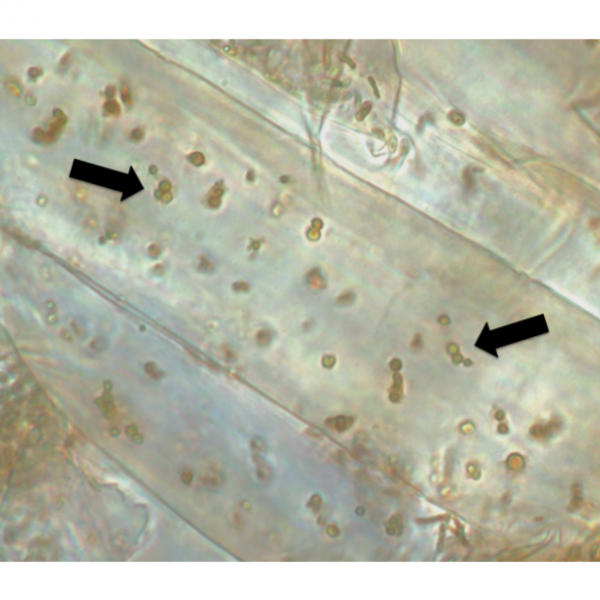
News Source
"There are tiny, unseeable creatures doing tiny, unseeable things to help people, wildlife and plants all around us.
Microbes are everywhere—inside the dirt, on your dog and even in your stomach. And scientists increasingly want to harness their powers for good.
One way could be to manage invasive species.
Phragmites australis, also known as the “common reed,” is an invasive plant that outcompetes most everything in its path. Growing up to 15 feet tall, it’s obliterating habitats, diminishing property values and creating roadside hazards, said Heather Braun, a project manager for the Great Lakes Commission and a member of the “core team” of the Great Lakes Phragmites Collaborative.
“It’s so thick and robust, we have photos of it growing through asphalt,” Braun said.
It’s a fire hazard too. The dry reed burns hot—“Like, the-fire-can-melt-cars hot,” Braun said.
Right now, the plant is managed with herbicides and mowing. The Great Lakes Phragmites Collaborative, a group of experts working to manage the plant, is exploring cheaper and more sustainable alternatives.
One option is a non-native insect. The collaborative is investigating if several species of a European stem-boring moth can be enlisted in the battle, Braun said. The moths pupate inside Phragmites stems and emerge as adults in the summer, causing the shoots to wilt.
The idea is not without precedence. Wasps have been recruited in the battle against the emerald ash borer.
-Not a silver bullet-
But evaluating foreign bugs for introduction in North America requires following a complex regulatory system. It could be years before their use is approved or denied.
And Braun and the collaborative are wary of putting all of their eggs in the bug-that-eats-Phragmites basket.
“A single species is not a silver bullet,” she said. *
So the researchers are also investigating the “microbiomes” of Phragmites—the populations of bacterial and fungal microbes that can promote, inhibit or have no effect on growth.
“We know that plants have a symbiotic relationship with microbes,” said Kurt Kowalski, a research ecologist at the U.S. Geological Survey – Great Lakes Science Center in Ann Arbor.
What we don’t yet know is if those relationships can be manipulated to control Phragmites.
-Finding the needle by shrinking the haystack-
If researchers identify a microbe that inhibits the growth of Phragmites, they can introduce it to dense populations of the reed to slow it down. If they find a microbe that enhances the growth and fortitude of Phragmites, they can find ways to eliminate it.
It’s been done before—a bacteria has been successfully used to manage the invasive and competitive cheatgrass in the western United States.
But finding a microbe that performs so well and affects so few plant species is rare, said James White, a professor of plant biology and pathology at Rutgers University and a member of the collaborative. It is like finding a needle in a very large haystack.
“There’s a lot we don’t know,” Kowalski said.
But the collaborative is shrinking that haystack. Its approach is to first identify which microbes are influential to Phragmites—taking an inventory of what’s there. The researchers now want to figure out the roles those microbes play. Do they help or harm the plant? Next they’ll target specific microbial relationships that have potential for controlling Phragmites.
Finally they’ll test the effectiveness and feasibility of the methods they identify.
Right now they’re at step one.
-Microbe inventory-
White is looking at the not harmful bacteria colonizing Phragmites to determine if they help the plant grow.
He has identified some that do, including a bacteria that protects Phragmites from salt stress, which would be important for thriving in high-salt environments like the lakeshore.
His next goal is to develop more controlled techniques of studying microbes.
“If we do [the experiments] in the greenhouse or in the field,” White said, “there are microbes everywhere.” It’s hard to know exactly what all those microbes do and how they interact with the ones being studied.
“We want a very controlled experiment,” White said.
Keith Clay, a professor of biology at Indiana University and also a member of the collaborative, has studied fungal microbes from Phragmites throughout the Great Lakes region.
These microbes don’t differ from region to region within the Great Lakes, Clay said. So if one proves to be practical for controlling Phragmites, it could be used universally throughout the region.
The same is not true on a larger geographical scale. The fungal microbes on Great Lakes Phragmites are quite different from those found in Europe, Clay said. So a unique approach would probably have to be developed for Phragmites management in the South, for instance.
There’s still much to learn about Phragmites and the microbes it hosts.
“We’re very early in these kind of microbiome studies,” White said. But he’s optimistic.
“I think there’s a lot of potential in this whole area of managing,” he said."
Author Credit: Marie Orttenburger